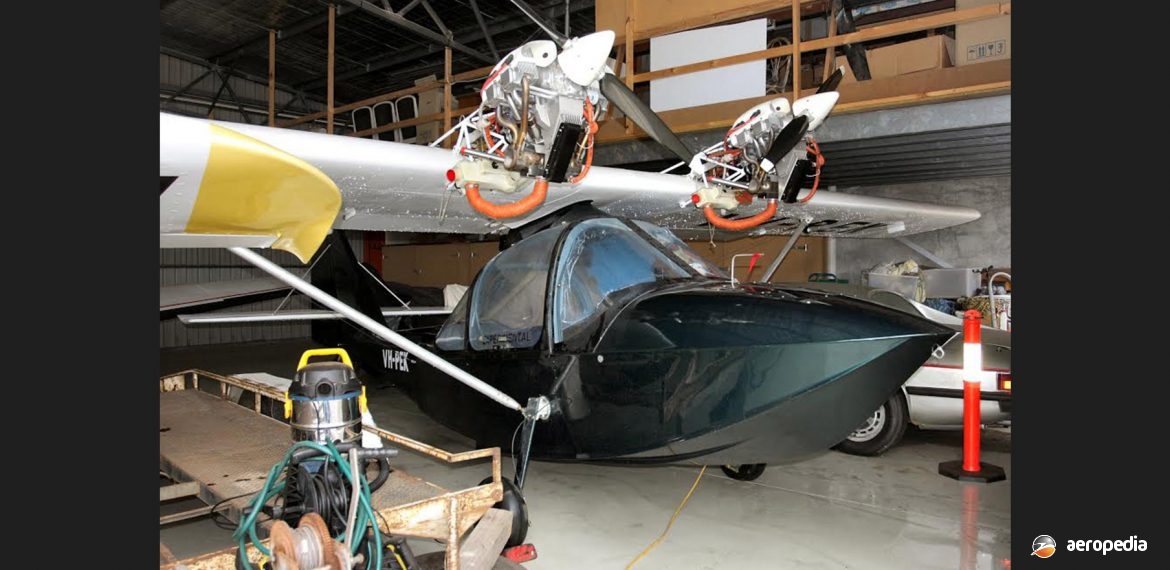Photograph:
Gidroplan Che-22 Korvet VH-PEK at Tyabb, VIC in 2010 (unknown)
Country of origin:
Russia
Description:
Light twin-engine parasol wing amphibian
Power Plant:
Two 48 kw (64 hp) Rotax 582 four-cylinder horizontally-opposed liquid-and-air-cooled engines
Specifications:
- Wingspan: 10.53 m (34 ft 7 in)
- Length: 7.25 m (23 ft 9 in)
- Height: 2.4 m (7 ft 10 in)
- Wing area: 16.4 m² (176.5 sq ft)
- Max speed: 159 km/h (99 mph)
- Cruising speed: 130 km/h (81 mph)
- Service ceiling: 3,000 m (9,800 ft)
- Rate of climb: 421 m/min (1,380 ft/min)
- Range: 450 km (280 miles)
- Take-off run on land: 80 m (262 ft)
- Take-off run on water: 90 m (295 ft)
- Fuel capacity [standard]: 100 litres (22 Imp gals)
- Fuel capacity [optional]: 130 litres (28.6 Imp gals)
- Loaded weight: 675 kg (1,488 lb)
History:
Designed by Boris Chernov, the Korvet (Corvette) was a light, sport three-seat amphibian, designed and built in St Petersburg in Russia, and was one of a series of light amphibians and flying boats produced by the Gidroplan Company. The first of the designs was the Che-20, which was eventually developed to the Che-22, which made its first flight in 1993, receiving its Russian certification in December 2001, and receiving JAR/FAR certification shortly thereafter. Some 80 examples are known to have been completed.
During initial production a number of changes were made to the design, including a major re-design of the wing. The amphibian has been produced by Gidroplan Company (which is Hydroplane in English) or Gidrosamolet.
The wing was a single spar riveted duralumin covered structure with full span slotted flaperons, these being fabric covered. The wing-tips turned down to support the wings when the aircraft was moored on water. Later models had floating bodies to provide stability at speed on water. Accommodation was provided for a pilot and two passengers in an enclosed cockpit.
A number of variants have been recorded as being available. The first aircraft was the Che-22P1, which was fitted with a single Rotax 582 engine. This was followed by the Korvet 503 with two Rotax 503UL engines; and the Korvet 582 with two Rotax 582UL engines; the Korvet J with two Jabiru 2200 engines, first flown in 2003 with wing-tip floats; the Korvet L with revised hydrodynamic float extensions; the Korvet Single with a single Jabiru 2200 engine; and the Korvet Kabriolet with an open cockpit and a single Jabiru 2200 engine.
A variant appeared at the Experimental Aircraft Association (EAA) event at Oshkosh in Wisconsin, USA in 2000, being advertised as the Refly Pelican, and was aimed at the American market. A development became known as the Chernov Che-23, which was a two-seat variant which could be fitted with the Rotax 582UL engine or the Rotax 912UL.
Examples have been sold to The Philippines, Vietnam, Spain, China and Cuba, the latter example being in military markings. One was fitted out for earth resource survey and had underwing aerials but these were later installed in the cockpit. The aircraft could be obtained as a fly away aircraft, or in kit form.
One example was imported to Australia in about 2007 by Douglas Thomas, who also previously built a Progressive Aerodyne SeaRey amphibian. However, due to his overseas commitments, the aircraft was still incomplete late in 2017 but the registration VH-PEK had been painted on the aircraft, which was nearing completion.

